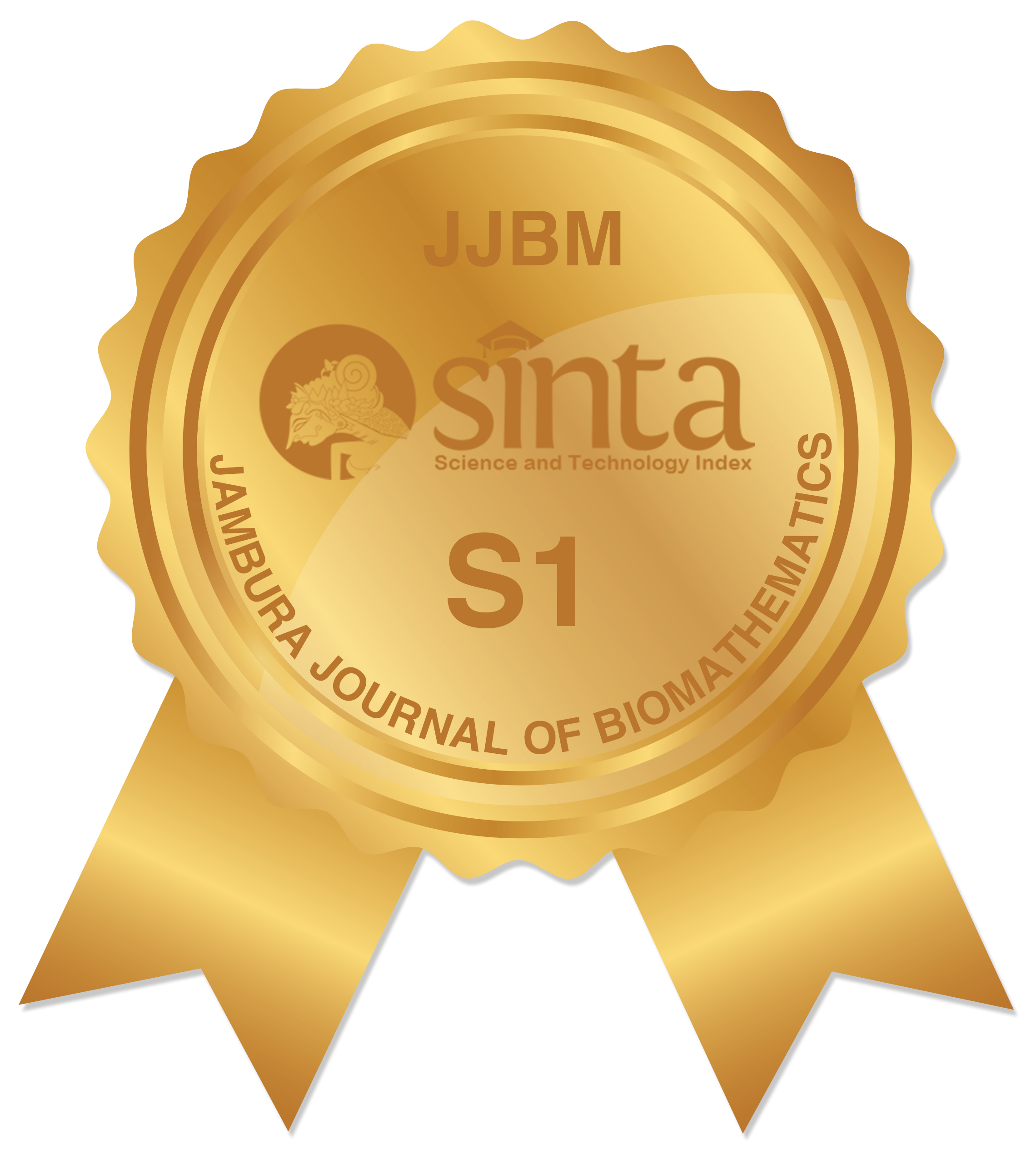Model matematika penyebaran COVID-19 dengan penggunaan masker kesehatan dan karantina
Abstract
Keywords
Full Text:
PDFReferences
H. A. Diah Handayani, Dwi Rendra Hadi, Fathiyah Isbaniah, Erlina Burhan, "Penyakit Virus Corona 2019" J. RESPIROLOGI Indones., vol. 40, no. 3, pp. 119-129, 2020.
Fathiyah Isbaniah and Agus Dwi Susanto, "Pneumonia Corona Virus Infection Disease-19 (COVID-19)" J. Indones. Med. Assoc., vol. 70, no. 4, pp. 87-94, 2020, doi: 10.47830/jinma-vol.70.4-2020-235.
M. Manaqib, I. Fauziah, and M. Mujiyanti, "Mathematical Model for MERS-COV Disease Transmission with Medical Mask Usage and Vaccination" Inpr. Indones. J. Pure Appl. Math., vol. 1, no. 2, pp. 30-42, 2019, doi: 10.15408/inprime.v1i2.13553.
Y. Yuliana, "Corona virus diseases (Covid-19): Sebuah tinjauan literatur" Wellness Heal. Mag., vol. 2, no. 1, pp. 187-192, 2020, doi: 10.30604/well.95212020.
C. C. Lai, S. Y. Chen, M. Y. Yen, P. I. Lee, W. C. Ko, and P. R. Hsueh, "The impact of COVID-19 preventative measures on airborne/droplet-transmitted infectious diseases in Taiwan" J. Infect., no. xxxx, pp. 1-2, 2020, doi: 10.1016/j.jinf.2020.11.029.
M. Jayaweera, H. Perera, B. Gunawardana, and J. Manatunge, "Transmission of COVID-19 virus by droplets and aerosols: A critical review on the unresolved dichotomy" Environ. Res., vol. 188, no. June, 2020, doi: 10.1016/j.envres.2020.109819.
P. Anfinrud, V. Stadnytskyi, C. E. Bax, and A. Bax, "Visualizing Speech-Generated Oral Fluid Droplets with Laser Light Scattering" N. Engl. J. Med., vol. 382, no. 21, pp. 2061-2063, 2020, doi: 10.1056/nejmc2007800.
M. Ali, S. T. H. Shah, M. Imran, and A. Khan, "The role of asymptomatic class, quarantine and isolation in the transmission of COVID-19" Journal of Biological Dynamics, vol. 14, no. 1. pp. 389-408, 2020, doi: 10.1080/17513758.2020.1773000.
WHO, "WHO director-general's opening remarks." 2020. https://www.who.int/dg/speeches/%0Adetail/who-director-general-s-opening-remarks-at-the-media-briefing-on%02covid-19-11-march-2020. (accessed Feb. 11, 2021).
Komite Pengendalian Covid-19 dan Pemulihan Ekonomi Nasional (KPC PEN), "Peta Sebaran COVID-19." https://covid19.go.id/peta-sebaran-covid19 (accessed May 11, 2021).
Komite Pengendalian Covid-19 dan Pemulihan Ekonomi Nasional (KPC PEN), "Lakukan Semua: 3M, 3T, dan Vaksinasi." https://covid19.go.id/p/berita/lakukan-semua-3m-3t-dan-vaksinasi.
I. Taufiq and D. Agustito, "Application of Mathematical Models Two Predators and Infected Prey by Pesticide Control in Nilaparvata Lugens Spreading in Bantul Regency" Inpr. Indones. J. Pure Appl. Math., vol. 2, no. 1, pp. 41-50, 2020, doi: 10.15408/inprime.v2i1.14887.
W. O. Kermack and A. G. McKendrick, "A Contribution to the Mathematical Theory of Epidemics" Proc. R. Soc. London. Ser. A, Contain. Pap. a Math. Phys. Character, vol. 115, no. 772, pp. 700-721, Feb. 1927, [Online]. Available: http://www.jstor.org/stable/94815.
G. O. Fosu, J. M. Opong, and J. K. Appati, "Construction of Compartmental Models for COVID-19 with Quarantine, Lockdown and Vaccine Interventions" SSRN Electron. J., pp. 1-15, 2020, doi: 10.2139/ssrn.3574020.
M. Imran, M. Wu, Y. Zhao, E. BeÅŸe, and M. J. Khan, "Mathematical Modelling of SIR for COVID-19 Forecasting" no. February, 2021, doi: 10.24205/03276716.2020.2018.
M. Ivanova and L. Dospatliev, "DATA ANALYTICS AND SIR MODELING OF COVID-19 IN BULGARIA" Int. J. Apllied Math., vol. 33, Jan. 2021, doi: 10.12732/ijam.v33i6.10.
Z. Liao, P. Lan, Z. Liao, Y. Zhang, and S. Liu, "TW-SIR: time-window based SIR for COVID-19 forecasts" Sci. Rep., vol. 10, no. 1, pp. 1-16, 2020, doi: 10.1038/s41598-020-80007-8.
A. Mitra, "Covid-19 in India and Sir Model" J. Mech. Contin. Math. Sci., vol. 15, no. 7, 2020, doi: 10.26782/jmcms.2020.07.00001.
M. Amaku et al., "Modelling the test, trace and quarantine strategy to control the COVID-19 epidemic in the state of São Paulo, Brazil" Infect. Dis. Model., vol. 6, pp. 46-55, 2021, doi: 10.1016/j.idm.2020.11.004.
M. Chinazzi et al., "The effect of travel restrictions on the spread of the 2019 novel coronavirus (2019-nCoV) outbreak" medRxiv, vol. 9757, no. March, pp. 1-12, 2020, doi: 10.1101/2020.02.09.20021261.
B. Tang et al., "The effectiveness of quarantine and isolation determine the trend of the COVID-19 epidemics in the final phase of the current outbreak in China" International Journal of Infectious Diseases, vol. 95. pp. 288-293, 2020, doi: 10.1016/j.ijid.2020.03.018.
Y. Xiang, Y. Jia, L. Chen, L. Guo, B. Shu, and E. Long, "COVID-19 epidemic prediction and the impact of public health interventions: A review of COVID-19 epidemic models" Infect. Dis. Model., vol. 6, no. 24, pp. 324-342, 2021, doi: 10.1016/j.idm.2021.01.001.
D. Aldila, H. Padma, K. Khotimah, B. Desjwiandra, and H. Tasman, "Analyzing the MERS disease control strategy through an optimal control problem" Int. J. Appl. Math. Comput. Sci., vol. 28, no. 1, pp. 169-184, 2018, doi: 10.2478/amcs-2018-0013.
N. Inayah, M. Manaqib, N. Fitriyati, and I. Yupinto, "Model Matematika Dari Penyebaran Penyakit Pulmonary Tuberculosis Dengan Penggunaan Masker Medis" BAREKENG J. Ilmu Mat. dan Terap., vol. 14, no. 3, pp. 461-472, 2020, doi: 10.30598/barekengvol14iss3pp461-472.
S. Wiggins, Introduction to Applied Nonlinear Dynamical Systems and Chaos, Second. New York: Springer, 2003.
Badan Pusat Statistik, "Hasil Sensus Penduduk 2020" 2020. https://www.bps.go.id/pressrelease/2021/01/21/1854/hasil-sensus-penduduk-2020.html.
B. K. Mishra et al., "COVID-19 created chaos across the globe: Three novel quarantine epidemic models" Chaos, Solitons & Fractals, vol. 138, p. 109928, 2020, doi: https://doi.org/10.1016/j.chaos.2020.109928.
S. S. Musa, S. Qureshi, S. Zhao, A. Yusuf, U. T. Mustapha, and D. He, "Mathematical modeling of COVID-19 epidemic with effect of awareness programs" Infectious Disease Modelling, vol. 6. pp. 448-460, 2021, doi: 10.1016/j.idm.2021.01.012.
N. Chitnis, J. M. Hyman, and J. M. Cushing, "Determining important parameters in the spread of malaria through the sensitivity analysis of a mathematical model." Bull. Math. Biol., vol. 70, no. 5, pp. 1272-1296, Jul. 2008, doi: 10.1007/s11538-008-9299-0.
R. Resmawan and L. Yahya, "Sensitifity Analysis of Mathematical Model of Coronavirus Disease (COVID-19) Transmission" Cauchy, vol. 6, no. 2, p. 91, 2020, doi: 10.18860/ca.v6i2.9165.
DOI: https://doi.org/10.34312/jjbm.v2i2.10483
Copyright (c) 2021 Muhammad Manaqib, Irma Fauziah, Eti Hartati

This work is licensed under a Creative Commons Attribution-NonCommercial 4.0 International License.
Jambura Journal of Biomathematics (JJBM) has been indexed by:
EDITORIAL OFFICE OF JAMBURA JOURNAL OF BIOMATHEMATICS |
 | Department of Mathematics, Faculty of Mathematics and Natural Science, Universitas Negeri Gorontalo Jl. Prof. Dr. Ing. B. J. Habibie, Moutong, Tilongkabila, Kabupaten Bone Bolango 96554, Gorontalo, Indonesia |
 | Email: editorial.jjbm@ung.ac.id |
 | +6281356190818 (WA Only) |
 | Jambura Journal of Biomathematics (JJBM) by Department of Mathematics Universitas Negeri Gorontalo is licensed under a Creative Commons Attribution-NonCommercial 4.0 International License. Powered by Public Knowledge Project OJS. |















